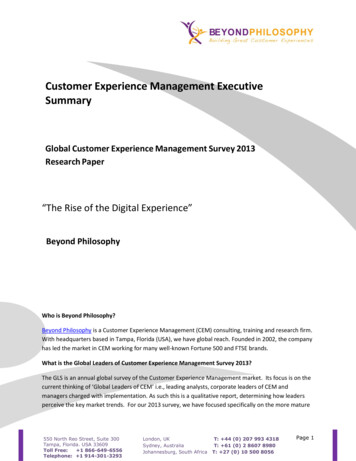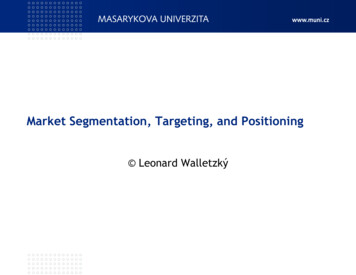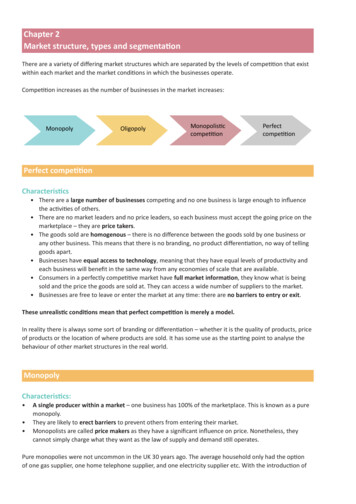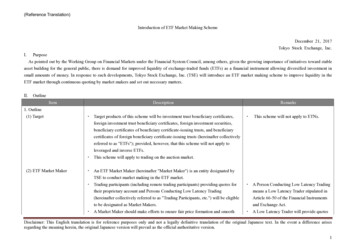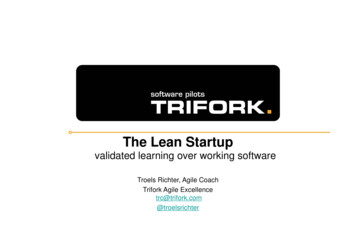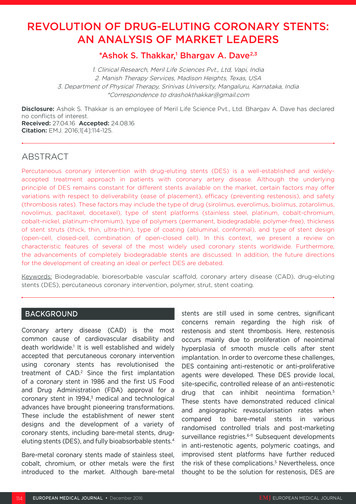
Transcription
REVOLUTION OF DRUG-ELUTING CORONARY STENTS:AN ANALYSIS OF MARKET LEADERS*Ashok S. Thakkar,1 Bhargav A. Dave2,31. Clinical Research, Meril Life Sciences Pvt., Ltd, Vapi, India2. Manish Therapy Services, Madison Heights, Texas, USA3. Department of Physical Therapy, Srinivas University, Mangaluru, Karnataka, India*Correspondence to drashokthakkar@gmail.comDisclosure: Ashok S. Thakkar is an employee of Meril Life Science Pvt., Ltd. Bhargav A. Dave has declaredno conflicts of interest.Received: 27.04.16 Accepted: 24.08.16Citation: EMJ. 2016;1[4]:114-125.ABSTRACTPercutaneous coronary intervention with drug-eluting stents (DES) is a well-established and widelyaccepted treatment approach in patients with coronary artery disease. Although the underlyingprinciple of DES remains constant for different stents available on the market, certain factors may offervariations with respect to deliverability (ease of placement), efficacy (preventing restenosis), and safety(thrombosis rates). These factors may include the type of drug (sirolimus, everolimus, biolimus, zotarolimus,novolimus, paclitaxel, docetaxel), type of stent platforms (stainless steel, platinum, cobalt-chromium,cobalt-nickel, platinum-chromium), type of polymers (permanent, biodegradable, polymer-free), thicknessof stent struts (thick, thin, ultra-thin), type of coating (abluminal, conformal), and type of stent design(open-cell, closed-cell, combination of open-closed cell). In this context, we present a review oncharacteristic features of several of the most widely used coronary stents worldwide. Furthermore,the advancements of completely biodegradable stents are discussed. In addition, the future directionsfor the development of creating an ideal or perfect DES are debated.Keywords: Biodegradable, bioresorbable vascular scaffold, coronary artery disease (CAD), drug-elutingstents (DES), percutaneous coronary intervention, polymer, strut, stent coating.BACKGROUNDCoronary artery disease (CAD) is the mostcommon cause of cardiovascular disability anddeath worldwide.1 It is well established and widelyaccepted that percutaneous coronary interventionusing coronary stents has revolutionised thetreatment of CAD.2 Since the first implantationof a coronary stent in 1986 and the first US Foodand Drug Administration (FDA) approval for acoronary stent in 1994,3 medical and technologicaladvances have brought pioneering transformations.These include the establishment of newer stentdesigns and the development of a variety ofcoronary stents, including bare-metal stents, drugeluting stents (DES), and fully bioabsorbable stents.4Bare-metal coronary stents made of stainless steel,cobalt, chromium, or other metals were the firstintroduced to the market. Although bare-metal114EUROPEAN MEDICAL JOURNAL December 2016stents are still used in some centres, significantconcerns remain regarding the high risk ofrestenosis and stent thrombosis. Here, restenosisoccurs mainly due to proliferation of neointimalhyperplasia of smooth muscle cells after stentimplantation. In order to overcome these challenges,DES containing anti-restenotic or anti-proliferativeagents were developed. These DES provide local,site-specific, controlled release of an anti-restenoticdrug that can inhibit neointima formation.5These stents have demonstrated reduced clinicaland angiographic revascularisation rates whencompared to bare-metal stents in variousrandomised controlled trials and post-marketingsurveillance registries.6-11 Subsequent developmentsin anti-restenotic agents, polymeric coatings, andimprovised stent platforms have further reducedthe risk of these complications.5 Nevertheless, oncethought to be the solution for restenosis, DES areEMJ EUROPEAN MEDICAL JOURNAL
now faced with their own challenges of late stentthrombosis. This has renewed interest in designinga better coronary stent.12 First-generation DESinclude sirolimus-eluting stents (2003) andpaclitaxel-eluting stents (2004), while the secondgeneration DES include zotarolimus-eluting stents(2008) and everolimus-eluting stents (2008), withpermanent polymer coatings.5 Newer-generationstents, including stents with biodegradablepolymers, polymer-free stents, and biodegradablestents, are the novel frontiers. While the safetyand efficacy of the majority of these stents aresupported by respective clinical trials and registries,larger trials and longer follow-ups are necessary toassess their long-term effectiveness.13The safety and efficacy of these DES are usuallyevaluated in clinical trials and registries in termsof major adverse cardiac events (as a compositeof cardiac death, myocardial infarction, and repeatrevascularisation) and stent thrombosis.14 Here itshould be noted that the cause of these adverseoutcomes could be multifactorial.15 Although theunderlying principle of DES remains constantfor different stents available on the market,certain factors may offer variations with respectto deliverability (ease of placement), efficacy(preventing restenosis), and safety (thrombosisrates). Apart from patient characteristics and lesioncomplexity, stent design and stent composition areidentified as important factors which may influenceclinical outcomes.16 In brief, these factors, shownin Figure 1, include the type of drug (sirolimus,everolimus, biolimus, zotarolimus, novolimus,paclitaxel, docetaxel), type of stent platforms(stainless steel, platinum, cobalt-chromium, cobaltnickel, platinum-chromium), type of ckness of stent struts (thick, thin, ultra-thin),type of coating (abluminal, conformal), and typeof stent design (open-cell, closed-cell, hybrid).Type of coating Abluminal ConformalType of drugTaxane groupof drugs ‘Olimus’ groupof drugsStrut thickness Thick Thin Ultra-thin Important stentcharacteristics Type ofstent designOpen-designClosed-designHybrid-design Type ofstent platformsSSCo-CrCo-NiPt-CrFully absorbablepolymersType of polymers Durable Biodegradable Polymer-freeFigure 1: Important characteristics of coronary stents that can influence clinical outcomes.SS: stainless steel; Co-Cr: cobalt-chromium; Co-Ni: cobalt-nickel; Pt-Cr: platinum-chromium.EUROPEAN MEDICAL JOURNAL December 2016EMJ EUROPEAN MEDICAL JOURNAL115
Table 1: Appraisal of design-related characteristics of most widely-used coronary drug-eluting stents.Stent nameManufacturerDrug StentplatformStrutthickness(µm)Axxion BioSensorsInternational(Boon TaxusExpress2 Boston Scientific(Marlborough,MA, USA)Paclitaxel(1 µg/mm2)Translute é Boston Scientific(Marlborough,MA, USA)Paclitaxel(1 µg/mm2)Translute SIBScopolymerDurable16Stainlesssteel97Ion Boston Scientific(Marlborough,MA, USA)Paclitaxel(1 atinumchromium81–86Promus Boston Scientific(Marlborough,MA, USA)Everolimus(1 µg/mm2)PBMA, romus Element Boston Scientific(Marlborough,MA, USA)Everolimus(1 µg/mm2)PBMA, 1Synergy Boston Scientific(Marlborough,MA, USA)Everolimus(1 µg/mm2)PLGABiodegradable4Platinumchromium74Xience V /XiencePrime /XienceAlpine /XienceXpedition Abbott Vascular(Green Oaks,IL, USA)Everolimus(1 µg/mm2)PBMA, ypher CordisCorporation(Baar,Switzerland)Sirolimus(1.4 µg/mm2)PEVA PBMADurable12.6Stainlesssteel140CypherSelect CordisCorporation(Baar,Switzerland)Sirolimus(1.4 µg/mm2)PEVA PBMADurable-Stainlesssteel100BioMime Meril LifeSciences(Gujarat, India)Sirolimus(1.25 µg/mm2)PLLA PLGABiodegradable2Cobaltchromium65OrsiroBiotronik (Bülach,SirolimusSwitzerland)Dual-polymer mix† Biodegradable7.4Cobaltchromium60–80Coroflex ISARB. Cobaltchromium60Ultimaster Terumo(Tokyo, egradable-Cobaltchromium80TransluminaYukon Choice GmbHTherapeuticsPCSirolimus(New Delhi, India)PLA inaYukon Choice GmbHTherapeuticsFlexSirolimus(New Delhi, India)PLA EAN MEDICAL JOURNAL December 2016EMJ EUROPEAN MEDICAL JOURNAL
Table 1 continued.Stent nameManufacturerDrug StentplatformStrutthickness(µm)Cre8 Alvimedica(Istanbul, Turkey)Amphilimus(Sirolimus Noneorganic acid)(0.9 µg/mm2)None-CobaltchromiumBioFreedom BioSensorsInternational(Boon Lay,Singapore)Biolimus A9NoneNone-StainlesssteelBioMatrix BioSensorsInternational(Boon Lay,Singapore)Biolimus A9PLABiodegradable10Stainlesssteel112–137Nobori Terumo(Tokyo, Japan)Biolimus A9PLABiodegradable20Stainlesssteel120Endeavor Medtronic(Dublin, Ireland)Zotarolimus(1 µg/mm2)Phosphorylcholine Durable4.3Cobaltchromium91EndeavorResolute Medtronic(Dublin, Ireland)Zotarolimus(1 ResoluteIntegrity Medtronic(Dublin, Ireland)Zotarolimus(1 soluteOnyx Medtronic(Dublin, Ireland)Zotarolimus(1 SolveElixir Medical(Sunnyvale,CA, USA)MyolimusMethacrylateDurable 3Cobaltchromium81DESyne NOVOLIMUS Elixir Medical(Sunnyvale,CA, 0*Polystyrene and polyisobutylene.†passive coating of PROBIO (amorphous silicon carbide) and active coating of BIOlute (PLLA).‡composed of hydrophobic C10, hydrophilic C19, and polyvinyl pyrrolidone.PBMA: poly(methacryloyl β-alanine); PVDF-HFP: polyvinylidenefluoro-hexafluoropropylene; PEVA: polyethyleneco-vinyl acetate; PLA: poly(lactic acid); PLGA: poly(dl-lactic-co-glycolic acid); PLLA: poly(L-lactic acid); SIBS:styrene-isobutylene-styrene.With this background, we scrutinised the availablepublished literature on DES for the presentreview. The search engines included PubMed,ScienceDirect, and Google Scholar. Accordingly,the most widely described coronary stents wereidentified and examined for their characteristics,including stent design, strut thickness, stentplatform, use of polymers, and the choiceof anti-restenotic drug (Table 1). Furthermore,the advancements in completely biodegradablestents are discussed (Table 2). In addition, futuredirections for the development of an ideal orperfect DES are debated.EUROPEAN MEDICAL JOURNAL December 2016ANTI-PROLIFERATIVE DRUGThe DES system is often distinguished by theanti-proliferative drug applied to the stent.FDA-approved first-generation DES, such as theCypher sirolimus-eluting stent (Cordis Corporation,Baar, Switzerland) and the Taxus Express2 gh, Massachusetts, USA) demonstratedpromising results compared to bare-metal stents.6-9However, these stents displayed potential forincreased inflammation, delayed healing, and latestent thrombosis, which could not be ignored.EMJ EUROPEAN MEDICAL JOURNAL117
Table 2: Appraisal of design-related characteristics of fully bioabsorbable/bioresorbable coronarystents/scaffolds.118Stent drugStrut thickness(µm)Resorptiontime (months)Igaki-Tamai Kyoto MedicalPlanning (Kyoto,Japan)PLLANoneNone17024–36REVAREVA Medical(San Diego, CA,USA)PTD-PCNoneNone20024ART 18AZArterialRemodelingTechnologies(ART) (Paris,France)PDLLANoneNone17018–24FADES Zorion Medical(Zionsville,IN, USA)Magnesiumalloy PLGANoneNone-6Fortitude AmaranthMedical(Mountain View,CA, �6AmaranthBRSAmaranthMedical(Mountain View,CA, iumalloyNoneNone165 tzerland)MagnesiumalloyPLLASirolimus1509MeRes 100 Meril LifeSciences(Gujarat, India)PLLAPDLLASirolimus10024–36ReZolve REVA Medical(San Diego,CA, USA)PTD-PCNoneSirolimus114–22824ReZolve 2REVA Medical(San Diego,CA, USA)PTD-PCNoneSirolimus10048Fantom REVA Medical(San Diego,CA, rofiberScaffoldMirage BRMS,Manli sorbHuaAnBiotechnology(Laiwu, China)PLLA PAL PCL PLGAPDLLASirolimus16024–36EUROPEAN MEDICAL JOURNAL December 2016EMJ EUROPEAN MEDICAL JOURNAL
Table 2 continued.Stent drugStrut thickness(µm)Resorptiontime (months)BTI scaffoldBioabsorbableTherapeutics Inc.(Menlo Park,CA, USA)Polymersalicylate linkerSalicylate different linkerSirolimus20012IDEAL BiostentBioabsorbableTherapeutics Inc.(Menlo Park,CA, USA)Polymersalicylate linkerSalicylate different linkerSirolimus17512AcuteOrbusNeich(Wan Chai, HongKong)PCL PDLLA PLLANoneSirolimus CD34150UnderinvestigationAbsorb BioresorbableVascularScaffold 1.1Abbott Vascular(Green Oaks,IL, USA)PLLAPDLLAEverolimus15624–36DESolveElixir Medical(Sunnyvale,CA, USA)PLLANoneMyolimus15012–24DESolve 100 NovolimusElixir Medical(Sunnyvale,CA, USA)PLLAPLLANovolimus10024PTD-PC: polytyrosine derived polycarbonate; PAL: poly(aspartic acid-co-lactide),PCL: poly(ε-caprolactone); PLLA: poly(L-lactic acid); PDLLA: poly(dl-lactide acid); PLGA:poly(dl-lactic-co-glycolic acid).This prompted the development of next-generationstents. Subsequently, many drugs have beenproposed and/or tested to reduce neointimalhyperplasia and/or inflammation with DES.17Overall, two major classes of anti-proliferativedrugs are used in DES. The ‘olimus’ group of drugs(i.e. sirolimus, everolimus, biolimus, and zotarolimus)act on the mammalian target of rapamycin,a key intermediary in the phosphatidylinositol3-kinase pathway,18 while the taxane group of drugs(i.e. paclitaxel, docetaxel) acts downstream ofthese pathways by inhibiting microtubularfunction, which is required for cell migrationand proliferation.19 Numerous clinic
114 EUROPEAN MEDICAL JOURNAL December 2016 EMJ EUROPEAN MEDICAL JOURNAL EUROPEAN MEDICAL JOURNAL December 2016 EMJ EUROPEAN MEDICAL JOURNAL 115 REVOLUTION OF DRUG-ELUTING CORONARY STENTS: AN ANALYSIS OF MARKET LEADERS *Ashok S. Thakkar,1 Bhargav A. Dave2,3 1. Clinical Research, Meril Life Sciences Pvt., Ltd, Vapi, India

